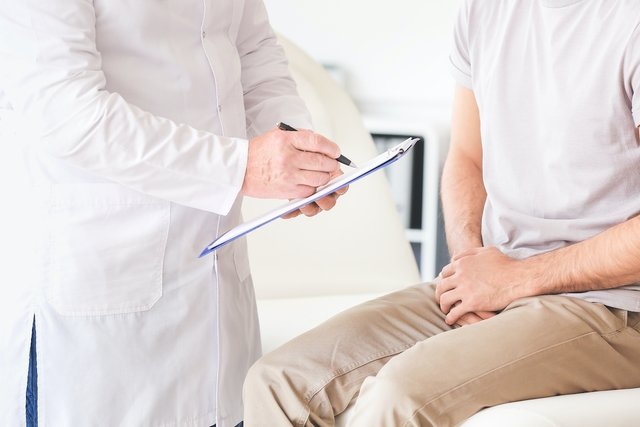The lump in the testicle can appear due to the accumulation of fluids or blood near the testicle, as in the case of hydrocele or varicocele, being a relatively common symptom that can appear in men of any age, from children to the elderly, but can also appear due to torsion in the testicle or even cancer.
Depending on its cause, the lump in the testicle may be accompanied by other symptoms, such as pain, swelling, sensitivity to touch, sensation of pressure, fever or chills, for example.
In the presence of a lump in the testicle, it is important to consult a urologist, so that its characteristics and associated symptoms can be assessed, so that the cause can be identified and the most appropriate treatment can be initiated. In the case of torsion of the testicle, you should seek hospital or go to the emergency room immediately.

Causes of lump in the testicle
The main causes of lumps in the testicle are:
1. Hydrocele
A hydrocele is a small pocket of fluid that accumulates near the testicle and can lead to a lump. This problem is more common in babies, but it can also happen in adult men, especially after the age of 40. Although it is not a serious problem, its size can vary greatly, and larger ones can even lead to pain and discomfort.
How to deal with: generally a hydrocele does not require any type of treatment, but if it is causing a lot of discomfort or does not regress naturally, the urologist may advise performing a small surgery with local anesthesia to make a small cut in the scrotum and remove the hydrocele. Learn more about hydrocele and when surgery is needed.
2. Varicocele
Varicocele is the main cause of lumps in the testicles and happens when the veins, which carry blood from the testicles, dilate and become wider than normal, ending up accumulating blood and generating the sensation of a lump. In these cases, it is also common to feel pain and a feeling of heaviness.
How to deal with: most of the time varicocele is controlled with analgesic medicines, such as dipyrone or paracetamol, but if there is a risk of infertility, the doctor may recommend surgery to close the vein that is dilated and only pass the blood through those that are still healthy , improving the functioning of the testicle. See all treatment options for varicocele.
3. Epididimite
Epididymitis appears when the epididymis, which is the structure that connects the testicle to the vas deferens, becomes inflamed, which usually happens due to a bacterial infection, especially in cases of unprotected sex. In addition to the feeling of a lump in the testicle, other symptoms such as pain, swelling of the testicle, fever and chills may also develop.
How to deal with: to treat epididymitis it is necessary to take antibiotics to combat the infection, generally with 1 injection of ceftriaxone and 10 days of use of doxycycline tablets or according to the urologist’s recommendation.
4. Testicle torsion
Torsion of the testicle is generally one of the easiest problems to identify in the testicle, as it causes sudden and very intense pain, as well as swelling and a lump in the testicle. Torsion is more common in boys and men under the age of 25.
How to deal with: testicular torsion is a medical emergency and, therefore, treatment with surgery must be carried out within the first 12 hours to prevent the death of testicular tissues. Therefore, in case of suspected torsion it is very important to go to the emergency room quickly. Understand more about when testicle torsion can happen.
5. Spermatocele
A spermatocele, also known as an epididymal cyst, consists of a small sac that forms in the epididymis, the place where the vas deferens connects to the testicle. In most cases, the cyst does not cause pain, but if it continues to grow over time, in addition to a lump attached to the testicle, pain or discomfort may also appear.
How to deal with: treatment is necessary when symptoms appear, and the urologist may recommend the use of analgesics or anti-inflammatories, such as paracetamol or ibuprofen. However, if there is no improvement after 2 weeks, surgery may be necessary to remove the cyst. Find out more about how the surgery is performed and what recovery is like.
6. Inguinal hernia
The emergence of inguinal hernias occurs when a portion of the intestine manages to pass through the abdominal muscles and, therefore, is more common in cases of abdominal weakness, as happens in children, the elderly and people who have had surgery. This hernia can sometimes protrude into the scrotum, creating the sensation of a lump in the testicle.
How to deal with: Inguinal hernia needs to be treated through surgery to replace the portion of the intestine inside the abdominal region. Find out more about how inguinal hernia is treated.
7. Testicular cancer
Although it is one of the rarest situations, developing testicular cancer can also cause a small lump to grow in the testicle. Normally, cancer develops without causing any type of pain, so it is very important that all types of lumps are evaluated by a urologist, even if they do not cause pain. See what signs may indicate cancer.
How to deal with: treatment usually begins with surgery to remove the affected testicle and all cancer cells, which is sufficient in less developed cases of cancer. In more advanced cases, treatment with radiotherapy or chemotherapy may be necessary after surgery, to eliminate any remaining tumor cells that may remain.
When to go to the doctor
Symptoms that indicate it is important to go to the emergency room quickly include:
- Very intense and sudden pain;
- Exaggerated swelling in the area;
- Increased sensitivity in the scrotum;
- Hard, painless lumps;
- Presence of one testicle higher than the other;
- Fever and chills;
- Nausea and vomiting.
However, in any case it is always important to go to the urologist to evaluate the lump, since, even if no symptoms appear, a problem may be developing that requires treatment or is more serious, such as cancer.

Sign up for our newsletter and stay up to date with exclusive news
that can transform your routine!
Warning: Undefined array key "title" in /home/storelat/public_html/wp-content/plugins/link-whisper-premium/templates/frontend/related-posts.php on line 12
Warning: Undefined array key "title_tag" in /home/storelat/public_html/wp-content/plugins/link-whisper-premium/templates/frontend/related-posts.php on line 13



